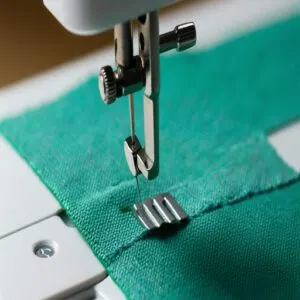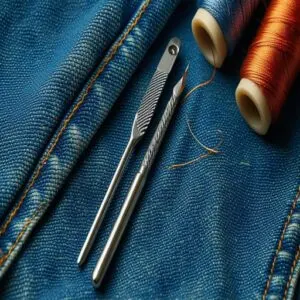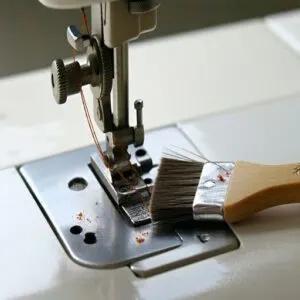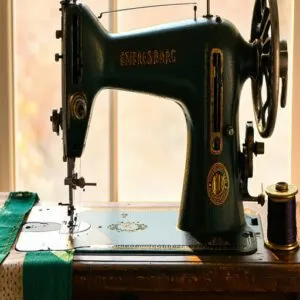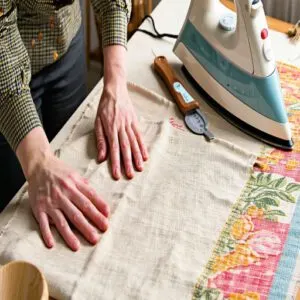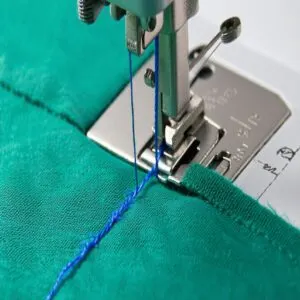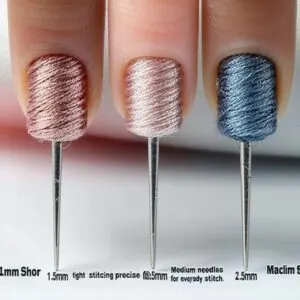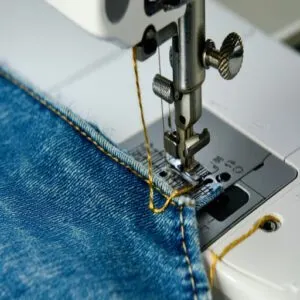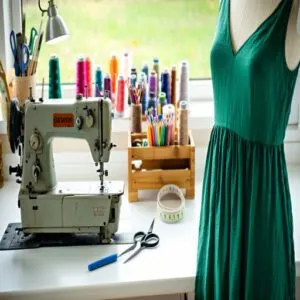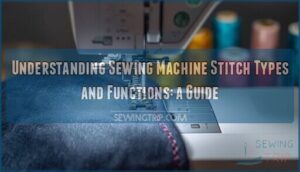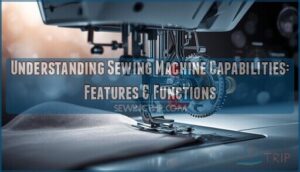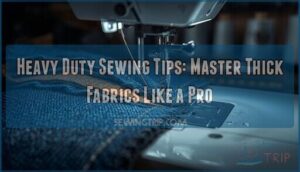This site is supported by our readers. We may earn a commission, at no cost to you, if you purchase through links.
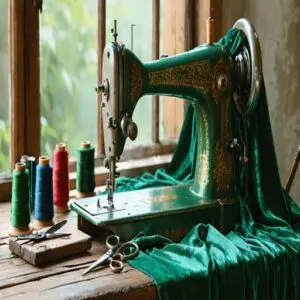
Start by keeping your sewing machine in tip-top shape—check the needle for damage, match it to your fabric, and clean out that lint-filled bobbin case.
Prewash and iron your fabric to avoid surprises later, and choose a presser foot that suits your material.
Speed things up by planning projects ahead, breaking steps into manageable chunks, and practicing consistent, smooth stitching.
Use high-quality thread and nail that stitch tension for flawless seams.
Remember, sewing’s a marathon, not a sprint—practice makes progress.
Ready for next-level tips that’ll have you stitching circles around the competition?
Table Of Contents
- Key Takeaways
- Sewing Machine Setup Tips
- Efficient Fabric Preparation
- Top 9 Sewing Speed Boosters
- 1. Black Embroidery Thread Bobbins Set
- 2. Adjustable Swivel Bar Stool Chair
- 3. White Polyester Sewing Machine Thread
- 4. Snap On Blindhem Presser Foot
- 5. Office Chair Mat for Carpet
- 6. Brother Sewing Machine Thread Bobbins
- 7. Janome Blind Hem Sewing Foot
- 8. Blind Stitch Sewing Machine Foot
- 9. Universal Sewing Machine Presser Foot
- Optimizing Sewing Techniques
- Streamlining Sewing Workflow
- Frequently Asked Questions (FAQs)
- Conclusion
Key Takeaways
- Keep your sewing machine clean and in good condition by inspecting the needle, cleaning the bobbin case, and ensuring proper thread tension for smooth operation.
- Prep your fabric by prewashing, pressing, and picking the right presser foot and needle for the material to avoid mistakes and improve efficiency.
- Plan your projects by breaking them into smaller steps, organizing your workspace, and using patterns and templates for precise cutting and sewing.
- Use tools like pre-wound bobbins, seam guides, and high-quality thread, combined with steady speed and rhythm, for faster and more accurate stitching.
Sewing Machine Setup Tips
Getting your sewing machine setup just right can save you tons of headaches—and time.
A quick check of your needle, bobbin, and overall machine condition will have you sewing smoothly in no time.
Inspect Needle for Sharpness and Condition
A dull or damaged needle can ruin your sewing speed and precision faster than you’d think.
Here’s how to stay sharp:
- Examine the needle tip for burrs or bends.
- Replace needles often to prevent fabric damage.
- Test with scrap fabric to check stitch quality.
- Listen for unusual sounds—needle condition impacts sewing accuracy!
To optimize your workflow, consider improving your sewing machine efficiency for better results, which is crucial for overall precision.
Select Appropriate Needle Type for Fabric and Machine
Switching gears, let’s talk needle type. A mismatched needle ruins sewing precision and slows you down.
Match your needle to fabric density and thread compatibility for smoother stitches. Need help picking?
Here’s a quick guide: To guarantee the best results, consider checking the needle selection criteria for your specific project.
| Fabric Type | Needle Type | Needle Size | Thread Type | Tip |
|---|---|---|---|---|
| Woven Cotton | Universal Needle | 80/12 | Polyester | Sharp for clean stitches |
| Knit Fabrics | Ballpoint Needle | 70/10-80/12 | Stretch Thread | Avoids fabric snags |
| Stretch Materials | Stretch Needle | 75/11 | Nylon | Reduces skipped stitches |
| Heavy Fabrics | Denim Needle | 90/14-100/16 | Heavy Duty | Handles thicker threads |
| Leather/Vinyl | Leather Needle | 90/14+ | Special Waxed | Creates clean punctures – sew slowly |
Clean Bobbin Case of Lint and Debris
Your sewing machine deserves some love—start with bobbin maintenance by cleaning out lint and debris.
A dirty bobbin case messes with thread tension and slows you down.
Keep it fresh with these quick tips:
- Pop out the bobbin case and wipe it clean with a lint-free cloth.
- Use a small brush for hard-to-reach spots.
- Check for thread tangles or damage.
Regular maintenance involves understanding bobbin case cleaning to prevent common issues, which is crucial for smooth operation.
Maintain Sewing Machine for Smooth Operation
A clean bobbin case is just the first step.
For smooth sewing machine operation, focus on needle alignment, thread tension, and regular sewing machine oil checks.
Sewing machine lubrication keeps parts gliding effortlessly, while proper bobbin maintenance avoids jams.
Don’t forget sewing motor care—oiling it guarantees consistent speed.
Mastering sewing machine maintenance speeds up projects and keeps frustrations away!
Efficient Fabric Preparation
You’ll save hours of frustration and countless do-overs when you prepare your fabric properly before sewing.
This involves steps such as prewashing to prevent unexpected shrinkage, and choosing the right presser foot for your material.
These prep steps will help you sew faster and more accurately.
Hold Fabric Gently, Avoiding Excessive Tension
Now that your machine’s ready to roll, let’s talk about your fabric handling game.
A gentle touch is your secret weapon for sewing accuracy and speed.
Think of your fabric like a dance partner – guide it smoothly without strangling it.
Too much tension control makes your fabric bunch up and fight back, leading to crooked stitches and sewing mistakes.
Keep your hands relaxed for fabric relaxation and smooth sewing flow.
Use Appropriate Presser Foot for Fabric Type
Paired with gentle fabric handling, your presser foot choice makes all the difference in sewing speed and accuracy.
Like picking the right dance partner, matching your presser foot to each fabric type prevents frustration and keeps your projects moving smoothly.
A quality Teflon presser foot can substantially improve sewing efficiency on challenging fabrics.
Teflon foot glides effortlessly over vinyl and leather, no sticking or struggling, which showcases its sewing efficiency.
Overlock foot tames those tricky knits and finishes raw edges beautifully, while an open-toe foot gives you perfect visibility for detailed work.
A gathering foot creates professional ruffles without the hassle, making it a valuable tool for your projects.
Let your presser foot be your project’s perfect companion, and watch your sewing efficiency soar, as it makes a significant difference in the overall quality and speed of your work.
Select Fabrics With Good Material Characteristics
Your fabric selection can make or break your sewing success.
Pick materials with balanced thread count and straightforward weave types – woven fabrics are perfect since they stay put while you work.
Test fabric characteristics before buying by giving it a gentle stretch and scrutinizing the fiber content.
Crisp, medium-weight cotton blends are your best friends when you’re chasing speed.
Your best approach to selecting the right fabric is to prioritize balanced thread count.
Prewash Fabric to Prevent Shrinkage and Wrinkles
Your smart fabric choice deserves proper textile care from the start.
This fabric preparation step removes factory chemicals and triggers natural shrinkage before cutting, so it is essential to begin with the right steps: toss your material in the washing machine with cold water for 10 minutes, then hang to dry.
Want to prevent fraying? Secure raw edges with a zigzag stitch or fray-check liquid for worry-free wrinkle reduction.
Top 9 Sewing Speed Boosters
You’ll love these nine must-have tools that’ll transform your sewing station into a speed-sewing powerhouse.
Whether you’re working on simple repairs or tackling complex projects, these practical additions will help you finish your work in half the time while maintaining professional-quality results.
1. Black Embroidery Thread Bobbins Set
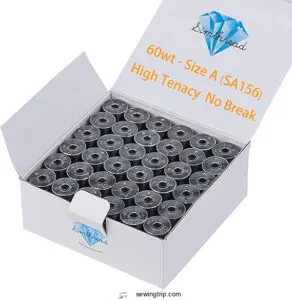
These black prefilled bobbins are a game-changer for your sewing routine.
You’ll get 144 SA156-sized bobbins packed with 60-weight premium polyester thread that won’t get gunky from machine oils.
They’re compatible with most machines, including Brother, Babylock, and Singer.
The high-tenacity 70D yarn maintains steady tension throughout your project, and you won’t waste time winding bobbins anymore.
Plus, the reduced friction means smoother stitching and fewer thread breaks.
For everyday sewing and embroidery projects, they’re worth every penny, offering smoother stitching.
Best For: Sewists and embroiderers who need consistent, high-quality black thread for smooth, efficient stitching on most major machine brands.
- Pre-wound bobbins save time and effort.
- High-tenacity polyester thread ensures steady tension and smooth stitching.
- Compatible with a wide range of popular sewing and embroidery machines.
- Limited to black thread, not suitable for all projects.
- May not fit older or specialty machine models.
- Slightly higher upfront cost compared to self-wound bobbins.
2. Adjustable Swivel Bar Stool Chair

The backbone of your sewing setup demands a task-mastering throne – an ergonomic swivel chair designed for comfort during those marathon projects.
You’ll want one that adjusts from 19.88 to 24.92 inches and supports up to 250 pounds, perfect for matching your table’s height.
The 360-degree swivel feature lets you glide between your machine and cutting space without the back-and-forth shuffle.
For durability and stability, choose a model with dual-wheel casters and black bonded leather – just budget 15 minutes for assembly, and you’re ready to roll.
Best For: People who need a sturdy, adjustable chair for tasks like sewing, crafting, or office work that offers comfort and mobility.
- Adjustable height range of 19.88 to 24.92 inches supports various desk or table setups.
- 360-degree swivel allows easy movement between workstations.
- Quick 10-15 minute assembly with durable chrome base and dual-wheel casters.
- May not roll easily on low-pile carpet surfaces.
- Lacks retaining screws in assembly, leading to potential slight instability for some users.
- Height may not suit all counter or taller desk setups.
3. White Polyester Sewing Machine Thread
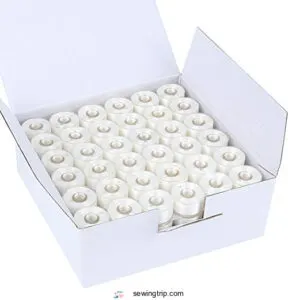
High-quality polyester thread is your fast-track ticket to smoother sewing.
At 70D/2 construction, these 144 prewound bobbins pack serious strength while gliding effortlessly through fabric.
You’ll love how they maintain consistent tension throughout your project, cutting down on frustrating breaks and snags.
Perfect for Brother, Babylock, and other major machines, their clear plastic sides prevent oil absorption and keep your tension steady.
When time’s tight, having these reliable bobbins ready to go means you’ll spend less time winding and more time creating.
Best For: Beginners and professionals looking for reliable, prewound polyester bobbins that are compatible with a variety of sewing machines.
- Prewound bobbins save time and increase efficiency.
- Consistent tension reduces thread breaks and snags.
- Clear plastic sides prevent oil absorption for smoother sewing.
- Limited to white color, which may not suit all projects.
- Polyester thread is not heat-resistant and can be damaged by high temperatures.
- May not fit older or less common sewing machine models.
4. Snap On Blindhem Presser Foot
Transform your hemming game with this premium Taiwanese snap-on foot that creates professional, invisible finishes.
You’ll craft the same sleek, undetectable hems found on store-bought dress pants, skirts, and curtains.
Installing is a breeze – just snap it on and align your fabric with the guide bar.
While it’s compatible with most Babylock and Brother machines (X56409001), check your model’s compatibility first to prevent fit issues.
The foot’s precision guide guarantees perfectly spaced stitches every time.
Best For: Beginners and home sewists looking to achieve clean, professional-looking hems without much hassle.
- Easy to install and use for a frustration-free setup.
- Creates invisible hems for a polished, store-bought look.
- Works on a variety of fabrics like dress pants, skirts, and curtains.
- Compatibility issues reported with certain Brother and Singer machines.
- May not fit all low shank machines without proper model matching.
- Some users reported bending or malfunction during initial use.
5. Office Chair Mat for Carpet
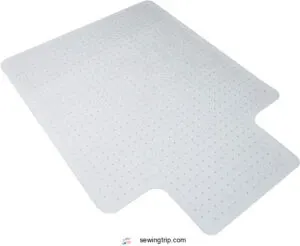
Rolling around your sewing space like a pro requires a sturdy foundation, and that’s where a quality carpet chair mat comes in.
You’ll want a polycarbonate mat with anti-skid features and gripping cleats that anchor firmly to your carpet, the ramped edges let you glide on and off smoothly, while the transparent design blends seamlessly with your floor.
Choose a 48" x 36" size to give yourself plenty of room for movement, just remember to place heavy objects on it while it flattens after unrolling, using a mat with anti-skid features will help prevent accidents.
Best For: Individuals with low-pile carpets looking to protect their flooring from chair wear and tear while maintaining a seamless look.
- Sturdy material with anti-skid features for stability.
- Transparent design blends well with the carpet.
- Ramped edges allow smooth chair movement on and off the mat.
- Ships rolled and may take up to 72 hours to flatten completely.
- Thin material may develop noticeable divots over time.
- Size may limit chair movement in larger workspaces.
6. Brother Sewing Machine Thread Bobbins
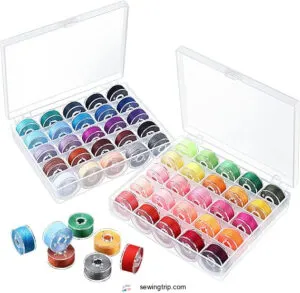
Up your sewing game with Brother’s thread bobbins that come in a set of 50 versatile colors.
You’ll speed through projects thanks to the clear organization box that lets you spot the perfect shade instantly.
Make sure to install them correctly – thread should unwind to the left in a ‘p‘ shape, not a ‘q,’ to prevent tension issues.
Just slide the shaft right, wind 5-6 times clockwise, and you’re set, which means the pre-wound bobbins work with multiple machine brands.
The pre-wound bobbins work with multiple machine brands, from Brother to Singer, saving precious prep time.
Best For: Sewing enthusiasts and DIYers who want a wide variety of pre-wound thread colors ready for quick use on multiple machine brands.
- Comes with 50 pre-wound bobbins in a range of vibrant colors.
- Compatible with popular sewing machine brands like Brother, Singer, and Janome.
- Includes a clear organization box for easy color selection and neat storage.
- May not fit less common or custom sewing machine models.
- Thread weight might be too light for heavy-duty sewing projects.
- Beginners might find the winding setup process tricky at first.
7. Janome Blind Hem Sewing Foot
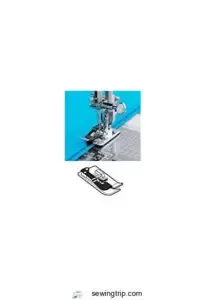
A versatile Janome blind hem foot brings precision to your sewing projects while boosting your speed.
You’ll get those professional-looking invisible hems on dress pants, skirts, and curtains without the fuss.
This high-quality foot installs easily and works with various fabrics, minimizing visible stitching and fabric puckering.
Just attach it to your machine, and you’re ready to create neat, polished finishes in half the time.
With proper maintenance and a bit of practice, you’ll wonder how you ever managed without this efficiency-boosting accessory that provides professional-looking results.
Best For: Home sewers and DIY enthusiasts looking for an easy way to achieve professional-looking blind hems on garments and home décor items.
- Easy to install and use with minimal setup time.
- Produces neat, professional-quality invisible hems.
- Reduces fabric puckering and enhances stitch control.
- Results may vary depending on fabric type and quality.
- Requires practice to perfect the technique for optimal results.
- Limited compatibility with machines outside the Janome brand family.
8. Blind Stitch Sewing Machine Foot
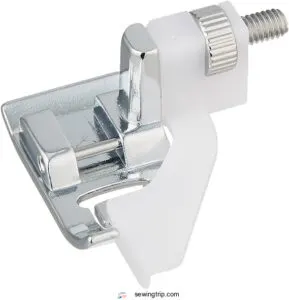
Just like using chopsticks, mastering the blind stitch foot takes practice but pays off in speed.
This clever attachment features a central guide that keeps your seams straight and consistent.
You’ll love how it creates nearly invisible hems on everything from pants to curtains, working beautifully with medium to heavy fabrics.
For those seeking the perfect fit, exploring the different top rated sewing machine feet can substantially enhance your sewing projects.
The adjustable sole plate securely holds your material while you work, and you can customize the stitch length to match your fabric.
For best results, fold and press your hem first, then let the guide do the work.
Best For: Home sewists and professionals looking to create clean, nearly invisible hems on medium to heavy fabrics like curtains and pants.
- Creates professional-looking, clean, and nearly invisible hems.
- Speeds up hemming compared to hand stitching, perfect for large projects.
- Adjustable settings make it versatile for various fabrics and stitch preferences.
- Requires some trial and error to master for optimal results.
- Instructions may not be clear for beginners.
- May not work as well with thinner or delicate fabrics.
9. Universal Sewing Machine Presser Foot
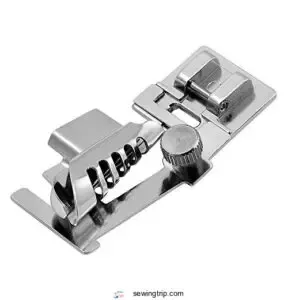
You’ll want this foot in your sewing arsenal – it’s a real game-changer for everyday projects.
Compatible with most low-shank machines like Singer, Brother, and Babylock, it keeps your fabric flat and stable while you work.
While you might need an adapter for some models, the improved accuracy and speed are worth it.
Just stick to regular projects since it’s not meant for heavy-duty materials.
Test different pressure settings with your fabrics, and you’ll notice smoother, faster sewing right away.
Best For: Beginner and intermediate sewists looking for a versatile, easy-to-use presser foot for everyday sewing tasks.
- Compatible with multiple low-shank machine brands like Singer, Brother, and Babylock.
- Keeps fabric flat and stable, improving sewing accuracy and speed.
- Versatile design suitable for most general sewing projects.
- Adapter may be required for some machines, adding an extra step.
- Not suitable for thick or heavy-duty materials.
- May require adjustments for optimal fit on certain machines.
Optimizing Sewing Techniques
You’ll be amazed at how much faster you can sew by mastering a few key techniques that focus on thread quality, tension, and stitch length.
Whether you’re a beginner or seasoned sewist, these proven tips will help you create professional-looking projects in less time, which can be achieved by focusing on key techniques.
Use High-quality Thread Appropriate for Fabric
The right thread does more than hold things together – it’s your ticket to faster, smoother sewing.
Match your thread type to your fabric: cotton for cotton pieces, polyester for synthetics, and silk for delicate work.
Proper thread selection for fabrics guarantees successful project outcomes.
You’ll see fewer snags and breaks, letting you maintain a steady rhythm.
For even better sewing performance, opt for quality corespun polyester threads when working with stretchy materials.
Ensure Correct Stitch Tension for Machine and Thread
Just as quality thread sets the stage, correct tension keeps your stitches strong and even.
Get familiar with your default tension setting—usually 4 or 5 on most machines.
Check your stitch quality by using different colored threads in your needle and bobbin.
If you spot the bobbin thread peeking through on top, loosen up.
Top thread showing underneath? Time to tighten things up a bit.
Practice Different Stitch Lengths for Various Seams
To master stitch variation, you’ll need to practice different lengths for each unique project need.
Your seam finishing and thread control will improve dramatically with the right stitch length choice.
Here’s what works best:
- Use shorter stitches (1.5-2mm) for delicate fabrics and tight curves
- Try medium stitches (2.5-3mm) for everyday sewing and straight seams
- Pick longer stitches (3.5-4mm) for basting and gathering
- Go for 3mm stitches when testing fabric handling
Use Reverse Button for Reinforcing Seams
Ever wondered why your seams come undone?
The reverse button is your secret weapon for seam reinforcement and sewing precision.
Lock those stitches at each end by hitting reverse for 3-4 stitches, then forward again.
Here’s how different fabrics need different stitch control approaches:
| Fabric Type | Reverse Length | Thread Tension |
|---|---|---|
| Lightweight | 2-3 stitches | Light/Medium |
| Medium | 3-4 stitches | Medium |
| Heavy | 4-5 stitches | Medium/High |
| Stretch | 5-6 stitches | Light |
Streamlining Sewing Workflow
You’ll find that having a streamlined workflow is like having a well-oiled sewing machine that helps you breeze through projects without getting tangled up in chaos.
By breaking down your sewing projects into smaller, manageable steps and organizing your workspace thoughtfully, you’ll transform your sewing sessions from scattered to super-efficient.
Plan Projects Carefully Before Starting
A solid plan transforms chaos into control.
Before starting any project, list your sewing goals and match them with dedicated time slots.
Thoughtful fabric selection is key to smoother workflow optimization.
For more detailed planning advice, explore these helpful sewing project planning ideas.
Keep patterns, tools, and supplies organized upfront – it’s the cornerstone of sewing productivity.
Skipping this step? You’re setting yourself up for inefficiency.
Break Down Large Projects Into Smaller Steps
Big projects can feel overwhelming, but breaking them up? Game changer.
Map out manageable steps and focus on one at a time.
- Task Management: List out every step—nothing’s too small.
- Time Blocking: Set specific time chunks for steps.
- Priority Setting: Knock out tricky tasks first.
- Batch Sewing: Group similar steps together.
- Workflow Optimization: Arrange tools for smooth sewing productivity.
Use Templates and Patterns for Accurate Cutting
Templates save sanity.
Rough fabric cutting? No thanks.
Pattern paper guarantees accurate cuts while template design cuts repeat errors.
Fabric measurement? A snap when using sewing patterns that fit right.
Invest in proper cutting tools for smooth edges and sewing accuracy tips galore.
Pattern assembly with clear guidelines means less fuss, more sewing.
Templates = stress-free precision every time.
Utilize Efficient Sewing Techniques for Seams
Mastering efficient sewing techniques for seams is a game-changer.
Stick with Seam Finishing methods like pinked edges or serging for clean results.
Keep Thread Management simple—avoid excessive trimming mid-project.
Smooth Fabric Handling cuts distractions, while Stitch Optimization helps you breeze through seams with precision.
These sewing efficiency hacks improve sewing speed without sacrificing sewing accuracy, freeing up time for creative sewing speed drills.
Practice Consistent Speed and Rhythm During Sewing
Getting into a rhythm while sewing is like finding your groove on a bike—smooth and steady wins the race.
Use your foot pedal to master Sewing Pace Control and keep fabric flowing evenly.
Speed Optimization happens when you balance control and rhythm, avoiding stops or jerks.
Practice sewing speed drills on scrap fabric to improve sewing speed and efficiency.
Frequently Asked Questions (FAQs)
How can I speed up my sewing?
Think of your sewing like a dance—set the rhythm by grouping tasks, like cutting, pinning, and pressing.
Use tools like pre-wound bobbins and line markings, and keep your workstation organized for smooth, uninterrupted moves.
How to sew more accurately?
Line up your fabric like a pro by using masking tape on your machine as a guide.
Test your stitches on scraps first, and slow down—rushing only invites wonky seams and regret.
Why is my sewing machine sewing so slow?
Your machine might be sewing slowly because of a dusty motor, tension issues, or an overly tight foot pedal screw.
Keep it clean, well-oiled, and adjusted, sometimes, a little TLC goes a long way!
How can practice improve your sewing skills?
Practice sharpens your sewing instincts—it’s like building muscle memory.
The more you tackle stitches, seams, and patterns, the smoother it becomes.
Make mistakes, learn from them, and soon sewing will feel almost second nature.
How can I reduce sewing machine noise?
Imagine your machine humming like a happy cat instead of growling.
Tighten loose screws, clean dirt from moving parts, and place a mat underneath.
A smooth tune-up keeps noise low and sewing peaceful.
What’s the best way to store fabric scraps?
Toss fabric scraps into clear bins or zip-top bags sorted by color or size.
It keeps things tidy and finding the right piece a breeze.
Bonus: stash tiny scraps for stuffing pillows or crafts!
How do I prevent slippery fabrics from shifting?
Did you know slippery fabrics can make your stitches wander off like a distracted toddler?
Use a walking foot, tissue paper, or spray starch for grip.
Pin strategically, and you’ll keep everything steady and secure.
What tools help with sewing straight seams?
A magnetic seam guide sticks to your machine and keeps your fabric aligned like magic.
Pair it with washi tape or masking tape to mark seam allowances, and you’ll nail perfectly straight lines every time.
How can I avoid running out of thread mid-seam?
Keep your bobbin full and pre-wind extras for backup.
Before starting a seam, check thread levels; it’s a lifesaver mid-project.
Think of it as packing snacks—better to have too much than too little!
Conclusion
Did you know organized sewing can save up to 30% of your time?
By following these tips to improve sewing speed and accuracy, you’ll work faster and create cleaner, more professional pieces.
Keep your tools in top shape, prep your fabric properly, and try out some speed-boosting gadgets.
Don’t forget, practice makes all the difference—small steps build big skills over time.
Ready to sew like a pro? Get started and watch your projects transform!
- https://www.gillymacdesigns.com/2020/06/seven-tips-for-accurate-sewing/
- https://mellysews.com/tips-faster-sewing/
- https://stitchingmall.com/increase-sewing-speed/
- https://oliverands.com/community/blog/2017/11/15-tips-to-improve-your-sewing.html
- https://vintageontap.com/5-most-common-sewing-beginner-problems/

